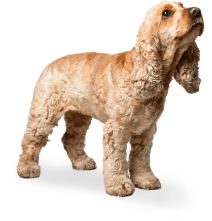

Your basket is currently empty.

Free UK Delivery. Exclusions apply.
Don't miss out! Add these must haves now.
Are you in the right place?
Please select your location so we can direct you to the right store...

Bolognese Dog
The Bolognese dog is a small, friendly dog that provides owners with plenty of fun! They may not be seen as commonly as other little white dog breeds, but the Bolognese certainly has a lot to offer. This breed is affectionate, as well as entertaining, and should provide years of loving companionship.

Like most pedigree breeds, they are prone to a few health issues, so it’s worth being familiar with them. To help, we’ve put together this handy guide to explore these further, as well as providing you with some top care tips for your Bolognese dog.
The Bolognese dog (also known as the ‘bolo’) is small and white, with a characteristically fluffy
coat. They were originally bred centuries ago and were popular with nobility in Bologna, Italy. However, as the years passed Bolognese numbers fell, and it almost became extinct at one point. However, efforts were made to restore the breed, and in 2002 they were shown at Crufts dog show for the first time.
They were originally bred for companionship, so the Bolognese temperament is loyal, affectionate, and gentle. They form strong bonds with their owners, but they may be a bit shy around strangers to begin with.
Bolognese dog life expectancy is often 12 years or more, with the right care.
Most Bolognese health issues are seen in many small breed pedigree dogs. We’re going to explore some of the most common ones here –
Dental disease – Excessive tartar buildup, gum inflammation, and tooth loss can occur without regular preventive care.
Legg-Calve-Perthes disease – A painful genetic condition that affects the hip joint. A lack of blood supply to the head of the femur causes bone death and joint disease, which often requires surgery.
Luxating patella – The kneecap slides out of position in one or both hind legs, which can cause
limping, pain, and arthritic changes.
Eye issues – Bolognese can suffer from cataracts and progressive retinal atrophy (PRA). Breeders should have their dogs' eyes screened before mating them, as these conditions can be hereditary.
There are no issues specific to Bolognese, but they can suffer from all the same digestive problems as other dogs, including –
Like many dogs, Bolognese can suffer from skin issues. Underlying skin allergies may be to blame for -
There are not many conditions that are specific to the Bolognese. They are generally healthy,
but they can develop illnesses that are common to all dogs. Keeping your dog at the correct bodyweight will help to reduce the risk of them developing conditions like diabetes and joint disease. Attending regular vet check ups will also help to ensure any emerging medical conditions are spotted quickly.
Purchasing your Bolognese from a reputable breeder that only uses healthy dogs is essential.
This will help to increase your chances of having a fit puppy. However, the right care and grooming will also impact your dog’s wellbeing, so it is important that you get this right throughout their life.
The top Bolognese dog diets focus on –
Correct feeding – Providing your pet with a good quality complete diet, which is appropriate for their age
and size.
Weight – Keeping your dog at a healthy weight will reduce their risk of other diseases. Weigh your pet’s food out accurately each day and avoid too many treats.
Supplements – Omega-3 fatty acids can support skin and coat condition, which can be particularly helpful for Bolognese with skin allergies. Essential fatty acids also help with joint and heart health.
The Bolognese temperament means they are relatively straightforward to train, with the right reward-based approach. They are intelligent and eager to please, which is a great combination when it comes to trainability. These dogs are usually well-bonded to their owners but can be a bit shy with strangers. Early socialisation with plenty of different people and situations is essential. Dogs that don’t receive the right socialisation from early puppyhood will be more likely to be fearful and anxious as adults.
Some Bolognese dogs can have hyperactive tendencies, but most only need up to 30 minutes of
exercise each day. This means that while they enjoy their playtime, they won’t usually keep going for hours on end. They were originally bred as companion lapdogs, so they will want to settle down and cuddle up after a short while.
Their interesting fluffy coat with its loose waves and curls lead many people to ask – do Bolognese
shed? Yes, they do, but they are classed as low shedders. This makes the Bolognese
hypoallergenic compared to many other breeds; however, they could still trigger reactions in sensitive allergy sufferers.
That characteristic coat does need some maintenance to keep it looking at its best. Bolognese
grooming involves regular brushing to prevent tangles and mats, especially if you choose to keep their coat long and natural-looking. Many owners decide that having their dog
regularly clipped is easier, which may mean a trip to the groomer every 6 weeks or so.
As well as keeping their coat in check -
If you are looking for a small, gentle, and affectionate lap dog, then the Bolognese might
be the right answer for you. These dogs are generally healthy with few inherited issues, but the right care will play a big role in their longevity and well being. Proper dental hygiene, a good quality diet, and the right nutritional supplements should help keep your Bolognese dog fit and well for many years to come.

Footer
Sign up to our newsletter
Thank you!
Join our email list for special offers and the latest news.
- PLUS -
Get 50% off your first 2 months** when you Subscribe & Save.

Enter your email for us to save your basket and receive all our special offers
Close the box to stay on the page